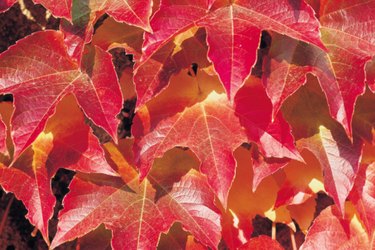
Don't be fooled. Real blueberry plants are shrubs that grow 3 to 8 feet high, depending on the variety and age of the plant. Some wild blueberry bushes have a compact, low-lying form, but none of them are vines. The blue, purple or black berries growing on climbing vines are almost always poisonous. Leave them be, and don't plant them where children can reach them.
Virginia Creeper
Video of the Day
Virginia creeper (Parthenocissus quinquefolia) is a deciduous vine grown ornamentally in landscapes, but also found wild throughout the U.S. This plant has serrated leaves that form in leaflets of five, and purple-blue berries in the fall that resemble blueberries. The berries are toxic to humans, although birds and other wildlife eat them. The leaves are tinged with red as they emerge in the spring, but turn a glossy green through the summer. Fall foliage is red and purple. Virginia creeper scrambles over fences and walls, and climbs shrubs and trees as well. In natural settings, it can become invasive. The plant is sometimes confused with poison ivy, which often grows in similar natural settings. Poison ivy has only three leaflets and produces white, waxy berries.
Video of the Day
Boston Ivy
Boston ivy or Japanese creeper (Parthenocissus tricuspidata), is a deciduous vine often used for covering masonry walls and fences. This plant has glossy green lobed leaves that turn red or purple in the fall. It climbs structures through the use of aerial rootlets and produces purple or blue berries in the fall. The berries are poisonous to humans. Boston ivy is related to Virginia creeper and resembles it in many ways. The leaves have three lobes instead of leaflets.
English ivy
English ivy (Hedera helix) is not related to Boston ivy, but is a vigorous evergreen vine with lobed green or variegated leaves. Mature branches produce blue to black poisonous berries in the fall. English ivy grows in the shade and is often used on masonry and stone structures. It climbs structures through aerial rootlets. The plant may lose its leaves in cold, unprotected settings. In warm, moist climates, English ivy may become invasive, scrambling over natural areas and smothering native shrubs and trees.
Considerations
Never eat berries unless you've positively identified them and know them to be safe. All bramble fruit berries, such as blackberries and raspberries, are safe to eat, but many round, smooth-skinned berries are toxic. A few, such as belladonna, or deadly nightshade, are lethal.